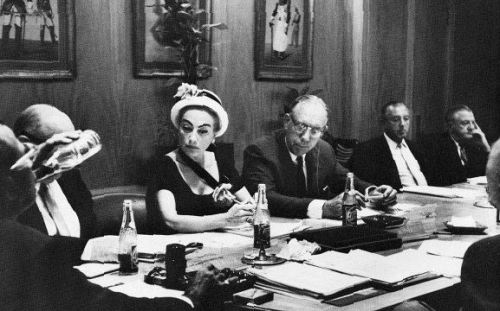
Bette Davis and Joan Crawford share a laugh.
The first season of the FX bio-series Feud came to a close on April 23, capping off 8 weeks of exploration into the famous rivalry between Bette Davis and Joan Crawford. With Jessica Lange as Joan Crawford, Susan Sarandon as Bette Davis, and Catherine Zeta-Jones as Olivia de Havilland, the series had been much anticipated in the classic film blogosphere and we waited on baited breath. Nearly all of us agreed–it had the potential to be either spectacularly good, or monstrously bad.
The evening of the first episode of Feud was an event. Tweets were coming in fast and furious as the episode progressed, with classic film aficionados noting errors as well as praiseworthy moments. Afterward, the reviews came in from fans of Crawford and Davis…and they were mixed. Several of my friends, classic film aficionados with expert knowledge on Bette Davis and Joan Crawford, loved it. Jessica Lange’s Joan Crawford, they said, was flawless. Susan Sarandon found the movements of Bette Davis, a very difficult thing to do. Others found it disrespectful and campy with trite dialogue, featuring such an inaccurate depiction of Olivia de Havilland that it was difficult to see much else.
I have had opinions about Feud from the start, but intentionally held off on expressing them here, because I wanted to wait for the end of the season. But now I feel that I can accurately describe my feelings on the subject.
To understand the context for Feud, it is necessary to understand the context of Hollywood during the studio era. On the set, friendships were not encouraged. Actors were to come to the set to work, and not to socialize with other actors. Studios would manufacture competition in order to make the actors work harder, which frequently led to feelings of isolation and loneliness among those working under the studio system. Given the studio-sanctioned psychological pressure and forced allegiance to the studio at which you were under contract, there was little time to branch out. If you had any time to socialize, it was almost exclusively with people at your own studio. With Bette Davis at Warner Bros. and Joan Crawford at MGM, a feud, as it were, was not present in those early days, nor was a friendship. Bette Davis said it best in her interview with Dick Cavett:
“It really depends on whom you work with. And, you see, we don’t work together very often. For instance, the group of people I knew the most were the people I worked with at Warner’s all those 18 years. And if I had been at Metro, I probably would have known those people much more, because they all knew each other. I don’t think it’s by any intent or jealousy or not wanting to know each other, I think all of those people you’re talking about were very occupied all those many, many years. And it does not leave much time, really, to have a lot of friends.”
Whatever animosity was cultivated later, culminating in the (admittedly fascinating) 1963 Oscars ceremony, was captured and played up in a press that feeds on scandal. Classic Hollywood feuds have long been fodder for magazines, tabloids, and newspaper gossip columns. Scandal sells, and publications have historically stopped at nothing to sell a scandal. But far too often, the feuds are either blown out of proportion or falsified altogether, and lives have been deeply affected by the practice of creating stories out of the lives of real people for the purposes of selling them. The rivalry between Olivia de Havilland and Joan Fontaine is a prime example. The sisters, while always rivals to some extent, had their relationship exposed, magnified, and milked for all its worth for the scandal-hungry press. The media coverage of their sibling troubles ultimately became a self-fulfilling prophecy–the sisters’ ups and downs became more frequent, and they stopped speaking altogether in the late 1970s.
Hollywood fights continue to make for good television and high ratings, so it didn’t come as a surprise to me that FX chose the Crawford/Davis feud for its first season of the show. A common thread among film fans when discussing Feud is praise for the show for bringing classic Hollywood into the mainstream. This is a wonderful objective, but there is a delicacy involved in such a task when the people represented aren’t alive to contribute to it. Respect and dignity for the people’s lives and legacies must be paramount, and my primary concern regarding Feud was the notion of bringing Crawford and Davis into the mainstream by way of a petty catfight.
Bette Davis, at the age of 28, violated her contract with Warner Bros due to unhappiness with the scripts and parts she was offered. She first fled to Canada to avoid legal action, then to Britain to take a 2-film deal. Suing Warner Bros in a British court in order to get out of her contract, Davis challenged Warner Bros on their suspension clauses–that if she didn’t take a film for any reason, she would be put on suspension and have that time added to the end of her contract. Warner Bros lawyers succeeded in making Davis look like a spoiled film star, and she lost the case, with the court ordering her back to Warner Bros to finish her contract. But it was among the first major strikes against the studio system, and Davis’ defiance and bravery in taking on one of the most powerful corporate enterprises in the country case set the stage for Olivia de Havilland to mount a similar case against Warner Bros in 1943–a case she won.
In 1955, Joan Crawford married Alfred Steele, the CEO of PepsiCo and the man who took Pepsi from a small regional bottling company to monolithic corporate giant. Crawford worked with Steele to bring increased revenue to the company, relocating from Hollywood to New York and traveling all over the country to make personal appearances at Pepsi events. When Steele died in 1959, Crawford discovered that he had left her deeply in debt, except for the Pepsi stock that she had saved, and her image. She was elected to replace Steele’s seat on the Pepsi Board of Directors, and thus became a powerful female executive in the corporate world.
While Feud did indeed touch upon these aspects of Crawford and Davis, for which I give the show credit, the focus remained on the fighting. I’m thrilled that mainstream networks are beginning to showcase classic Hollywood and bring it into the mainstream. But especially in our present day, as women find themselves fighting for their rights, I wish the action had centered around their strength, portraying Crawford and Davis as the powerful women they were, resisting the urge for the action to revolve around them as stereotypical, catfighting divas.






























_03.jpg)


Interesting write up! Although Feud was interesting at times, I feel like Catherine Zeta Jones’ portrayal of Olivia De Havilland could’ve been stronger. I also agree with you when it comes to the fighting. I thought there was too much emphasis on that.
Thank you! Yeah Olivia’s portrayal was a really big problem. And I’m glad you agree with me on the fighting aspect.
Hollywood today seems bereft of originality… There is good reason the films of the 1930s-40s clearly mark Hollywood’s Golden Age. Today, well, let’s just say they make movies and aim for the largest and most common audience… And leave it at that.
So am I correct to assume that FX will showcase another “FEUD” series next year, perhaps on DeHaviland and Fontaine? I did enjoy this first venture by FX, and thought Lange and Sarrandon gave outstanding performances as Crawford and Davis.
The next season is going to be Charles and Diana. I hope they don’t do Olivia and Joan, Olivia would not be happy at all.
I loved ‘Feud’. I thought Jessica Lange and Susan Sarandon were fantastic. The rest of the characters, like the aforementioned Catherine Zeta Jones as Oliva, jolted me out of the film with their lacking performances. While many seem bothered by the fights, the name of the series is ‘Feud’. Someone wouldn’t make a movie about the Hatfields and McCoys without most of the film being about fighting. And while you seemed to see the film as showing the women as powerless, the softness was integral to the series. The creators specifically stated they were trying to bring another dimension to popular culture’s harsh views of Joan Crawford and Bette Davis. They were fighting history to try to bring a more balanced view the both of them as human beings. They wanted to turn turn them from a stubborn, big eyed smoker and a shoulder pad wearing, fierce eye-browed hanger beater into women of strength, intelligence, resolve, and ambition, while allowing us to sympathize with their weaknesses and foibles. It was about more than just the show. It was about restoring the reputations of two incredibly talented women.
I hear you, and see what you’re saying. As I mentioned, lots of people loved it, so you’re not wrong. It wasn’t that I saw the women as depicted as powerless per se, it was that I wished they had focused on other aspects of their lives instead of taking them on in a show called FEUD.
It was well balance & well intentioned, not stooping to the ‘need’ that seems to be ingrained in nearly all of us by media manipulation & publicity machines. The employment scenario is not all that different from any Office, if you stop to think about it. You are not paid to socialise, but paid to work. If you do manage to make a few friends in that context, you must be careful. With luck, you won’t end up having confided something that needed to stay put with an overly ambitious & ruthless person who would betray your friendship. Time & technology have not changed that aspect of human nature, am sorry to say.
Oh certainly, I agree with you about the employment thing. The studio was similar to any other workplace, just more scrutinized. I do agree that Feud was well-intentioned. I just wish that they had chosen to honor these two particular very strong, very powerful women with something other than a fight.
Since I don’t have cable, I haven’t watched the show, but I’ve been following writeups with interest from the classic film community. This is one of the most thoughtful I have seen.
Wow, that’s a huge compliment, thank you for that.
Agreed. It would have been nice if they explored other times in their lives where they didn’t intersect, if it was more of a duel biography of sorts, instead of mainly focusing on the times Davis and Crawford’s lives collided.
Great post! I’m really looking forward to watching Feud on TV later this year. “Whatever Happened To Baby Jane” has been a favourite of mine for years. Strange how nothing changes though, the press have always stretched the truth for dramatic effect.
I love reading about classic movies and actors/actresses, including this one. Thank you for giving me a new blog to follow. 🙂
I enjoyed FEUD though I agree with several of the critiques here.
The series overall seemed to be more centered on Lange’s Crawford, and as such, it did one important thing very well – it dimmed the power of the cartoonish “Mommie Dearest” as the final word on Crawford, and gave viewers a more nuanced portrait of a flawed, damaged woman.